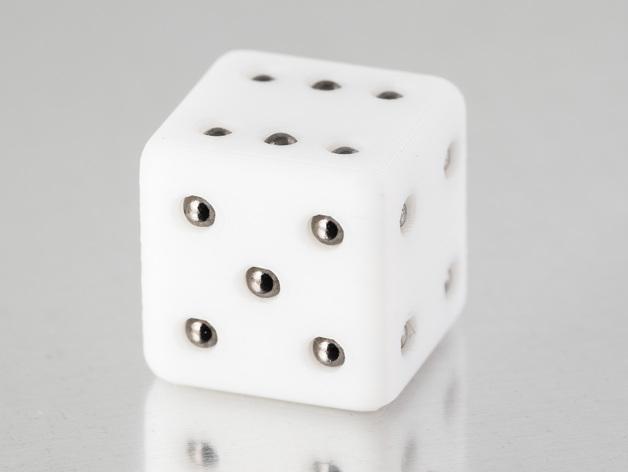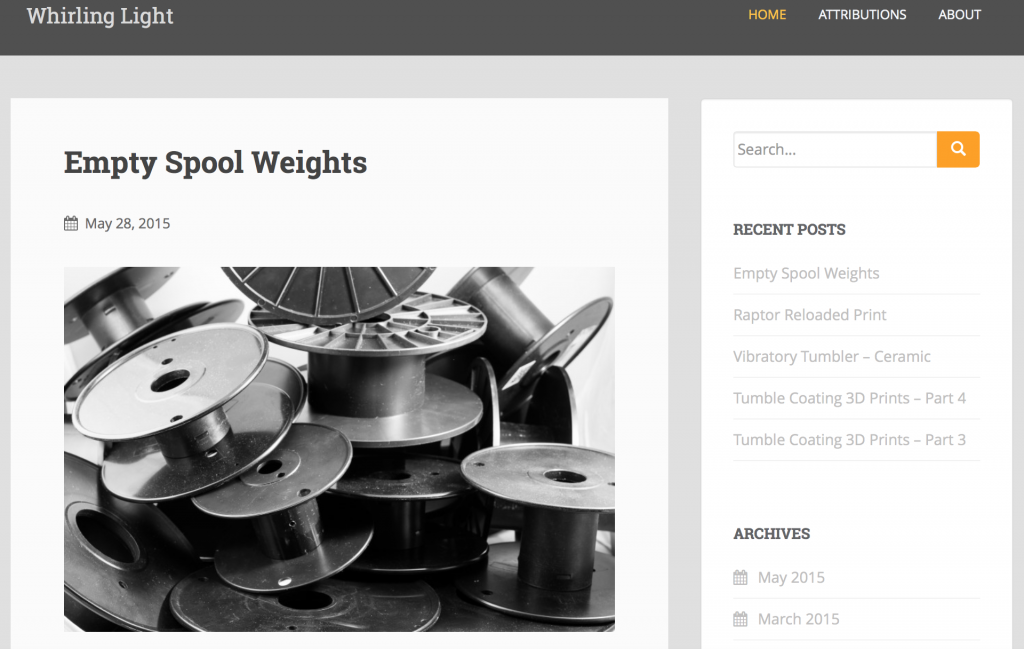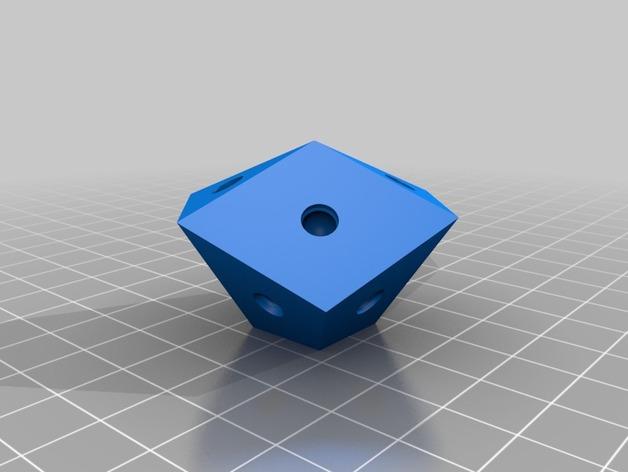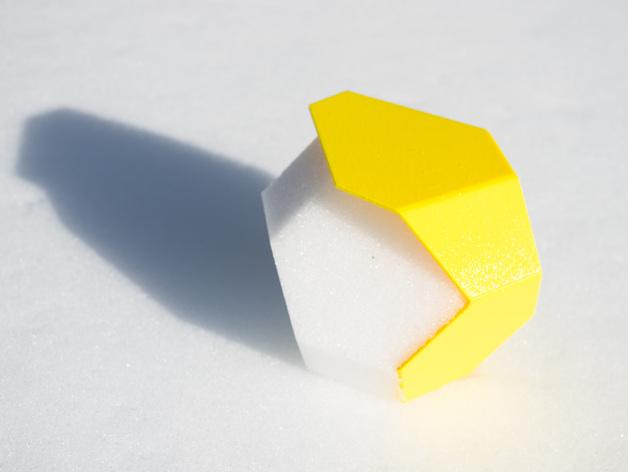In addition to being my top choice for the name of my next band, Magnetic Bisymmetric Hendecahedrons is just one set of 3D printed magnetic manipulables created by Walter Hsiao and shared on Thingiverse. Add to this a bit of the Menger sponge and a Schonhardt Polyhedron or two and you are swimming in the world of complex geometric forms occupied by Hsiao and many others who share his fascination.
Hsiao’s earlier experiments involved the creation of polyhedral (multi-faceted) molds in which snow could be packed to create a stackable, connectable form. Given the stickiness of good building snow, you can see how these modular units could provide a great number of tectonic possibilities…goodbye snowman and hello face centered cubic Voroni constructions!
Inspired by the work of FredBartels and Mathgrrl, and disappointed by the lack of snow in southern California, he later switched from printing polyhedral snow molds to multi-sided solids with magnets embedded in their faces to allow for assembly.
His first product in the series of multi-sided magnetic creations was a set of 3D printed hendecahedrons (eleven-sided-solids). Each side of the form is embedded with a single, round 3mm neodymium magnet that allows it to connect to any of the sides of as many hendecahedrons as one could ever wish to print. It’s like a magnetic set of Lego bricks…but each with 11 possible connections. The magnets’ rounded form allows them to rotate slightly in the depressions into which they are fitted so that they can move to adjust to the adjoining magnets’ polarity. That way, you never end up with two magnets repelling each other and disallowing a particular juncture.
In principle, this could be done with any multi-faceted solid, such as the rhombic dodecahedron, which is exactly what he worked with next. For this form, each side was embedded with two of the ball magnets. Demonstrating the all too familiar maker’s obsessive tinkering, humility when evaluating one’s own creations, lack of proprietary avarice, and willingness to go without great quantities of sleep, Hsiao detailed the process for creating the rhombic dodecahedrons and lessons learned.
“It probably took a few hours each. If I remember correctly,” he noted, “they were printed with 100% invite, 0.3mm extrusion width, 120 micron layers, 40 or 50mm/sec. I wouldn’t really recommend printing them at 100% infill, but I like the way the transparent filaments look at 100%. Normally I prefer to use 0.4mm nozzles or larger for 100% infill, but I went with the smaller nozzle for sharper corners.”
 He then moved on to create a die which uses 3mm neodymium magnets instead of the traditional colored dots to number the sides. Why? Because he could! Recognizing that experimentation isn’t a failure when it doesn’t lead to some immediately practical creation – something pleasantly well accepted in the 3D maker world – he shared the idea on Thingiverse for others to fold into their own explorations.
He then moved on to create a die which uses 3mm neodymium magnets instead of the traditional colored dots to number the sides. Why? Because he could! Recognizing that experimentation isn’t a failure when it doesn’t lead to some immediately practical creation – something pleasantly well accepted in the 3D maker world – he shared the idea on Thingiverse for others to fold into their own explorations.
 And, of course, each accomplishment simply moves the bar farther and Hsiao has aspirations for creating even more complex sets of connectables such as a 13-sided polyhedron, although he admits that is going to take some time as the coordinates require some complex figuring.
And, of course, each accomplishment simply moves the bar farther and Hsiao has aspirations for creating even more complex sets of connectables such as a 13-sided polyhedron, although he admits that is going to take some time as the coordinates require some complex figuring.
For those who believe that 3D printing is more science than art, that is refuted by the needs of each user to make adjustments to any print ‘recipe’ as materials, machines, and mistakes make it difficult to ever hand over a perfectly precise and completely flawless creation. Hsiao found that there was sufficient variation, for example, when printing with either PLA or ABS to create the need for individual variations:
“It may require some tweaking to get the sizing right (to account for printer settings, plastic shrink, variations in ball sizes, etc), the default scale worked well for me when printing in a variety of PLA filaments, but was a bit too tight for ABS. I printed with a 0.3mm nozzle to for sharper corners and more accurate details.”
 When he’s not creating, Hsiao loves to share his experiences and knowledge to help others who are coming up behind him. On his blog, Whirling Light, he shares helpful information such as calculating the weight of the remaining amount of filament on a partially used spool or the steps for a fascinating process for metal tumble coating 3D printed parts. In the meantime, he’s always willing to hear feedback and suggestions about his designs as he continually strives to improve and evolve his creations:
When he’s not creating, Hsiao loves to share his experiences and knowledge to help others who are coming up behind him. On his blog, Whirling Light, he shares helpful information such as calculating the weight of the remaining amount of filament on a partially used spool or the steps for a fascinating process for metal tumble coating 3D printed parts. In the meantime, he’s always willing to hear feedback and suggestions about his designs as he continually strives to improve and evolve his creations:
“The parts don’t stick together as strongly as I’d like and I think the tolerances may be too tight for some printers, but it’s fun to play with. It isn’t always obvious which way to orient the pieces which keeps it interesting and it’s fun to see what shapes you get when you combine them. I think a version using 5mm magnets will be more stable and easier to print and I plan on adding one when the magnets I ordered arrive.”
 His printer of choice these days is the RigidBot but he also uses his older Afinia and has plans to build a Eustanthios Spyder v2 and surely a new printer will require new modifications to these projects’ print processes and inspire new designs as well. In other words: keep your eyes on Walter Hsiao’s work…it’s magnetic.
His printer of choice these days is the RigidBot but he also uses his older Afinia and has plans to build a Eustanthios Spyder v2 and surely a new printer will require new modifications to these projects’ print processes and inspire new designs as well. In other words: keep your eyes on Walter Hsiao’s work…it’s magnetic.
Let us know what you think about these designs and concepts in the 3D Printed Magnetic Hendecahedron forum thread over at 3DPB.com.
Subscribe to Our Email Newsletter
Stay up-to-date on all the latest news from the 3D printing industry and receive information and offers from third party vendors.
You May Also Like
3D Printing News Briefs, April 13, 2024: Robotics, Orthotics, & Hypersonics
In 3D Printing News Briefs today, we’re focusing first on robotics, as Carnegie Mellon University’s new Robotics Innovation Center will house several community outreach programs, and Ugogo3D is now working...
Rail Giant Alstom Saves $15M with 3D Printing Automation Software 3D Spark
3D Spark has entered into a three-year deal with the rail giant Alstom. Alstom, a transport behemoth with annual revenues of $16 billion, specializes in the manufacture of trains, trams,...
Meltio Expands Global Reach with New Partnerships in the Americas and Europe
Spanish 3D printing manufacturer Meltio has expanded its sales network across the globe. With the addition of three new partners in the United States, Brazil, Argentina, and Italy, Meltio aims...
3D Printing Webinar and Event Roundup: April 7, 2024
Webinars and events in the 3D printing industry are picking back up this week! Sea-Air-Space is coming to Maryland, and SAE International is sponsoring a 3D Systems webinar about 3D...

































